 Heat Illness Prevention
Heat Illness Prevention 
What Causes Heat Illness?
What is in T8 CCR 3395?
Heat illness can be caused by environmental and personal risk factors.
T8CCR 3395 (b) Definitions states the following:
"Environmental risk factors for heat illness" means working conditions that create the possibility that heat illness could occur, including:
- Air temperature
- Relative humidity
- Radiant heat from the sun and other sources
- Conductive heat sources such as the ground
- Air movement
- Workload severity and duration
- Protective clothing and personal protective equipment worn by employees
"Personal risk factors for heat illness" means factors such as:
- Water consumption
- Alcohol consumption
- Degree of acclimatization
- Caffeine consumption
- Use of prescription medications that affect the body’s water retention or other physiological responses to heat.
- An individual’s age
- Health
More on What Causes Heat Illness
Outdoor Work Locations and Activities Where Employees May Be at Risk
Examples of common outdoor work locations and activities where employees may be at risk for heat illness include:
- Agricultural fields, forests, and parks (e.g., fruit and vegetable growing, cattle feed lots, lumber harvesting, nurseries, public safety, law enforcement, equipment maintenance)
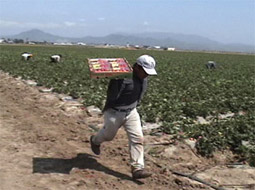
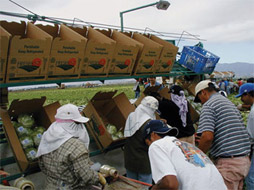

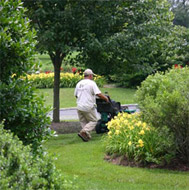

- Construction sites in which no building shell has been completed (e.g., carpentry, plumbing, roofing, masonry, structural steel erection)
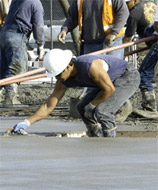
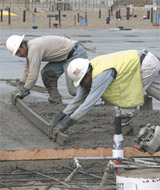
- Areas of construction sites that are outside building shells
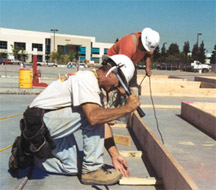
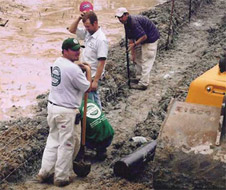
- Loading docks, tarmacs, and roads (e.g., dock workers, baggage handlers, postal workers, street painting and maintenance, sign maintenance and installation, asphalt paving, sidewalk construction, traffic sign and signal maintenance, road grading)



- Sheds, packing sheds, partial or temporary structures such as tents and lean-tos, and any other structure with open sides if they are heated by the sun and there is limited air circulation and/or no insulation.
- Equipment and storage yards (e.g., lumber, maintenance and automobile wrecking yards)
- Outdoor utility installations (e.g., natural gas distribution, irrigation and sanitary districts, utility poles, mosquito abatement districts)
- Landscaping
- Oil and gas extraction
- Transportation or delivery of agricultural products, construction materials or other heavy materials (e.g. furniture, lumber, freight, cargo, cabinets, industrial or commercial materials), except for employment that consists of operating an air-conditioned vehicle and does not include loading or unloading.
Note: Not all work locations where risks for heat illness may exist are mentioned above. One example is construction sites where building shells have just been completed. Those sites may have no insulation, air circulation, or cooling mechanisms and may be hotter than the surrounding outdoor environment.
Loss of Heat Balance
Heat illness results when the body is out of heat balance. Heat balance means that the heat the body produces equals the heat it looses. When the body is out of Heat balance it produces and retains more heat than it looses causing heat illness.
Sources of Body Heat
Heat building-up inside the body from moving muscles during physical work activities is the major source of heat build-up in the body. About 75% of the stored energy the body uses to do physical work is converted into heat. Only about 25% of the energy is converted into the movements required to perform work. The more strenuous the physical activity, the more internal heat the body produces. Performing physical work activities when risk factors for heat illness are present increases the internal heat the body produces.
Added to this internal heat is the external heat load on the body which comes from working where environmental risk factors (e.g., hot air, direct sunlight or lack of effective shading) are present. A major danger from warm and hot weather, high relative humidity and lack of air movement is that these factors greatly slow the body’s natural processes of releasing heat to the surrounding environment. All of these and other risk factors can increase the risk of heat illness.
Body Heat – Losses and Gains
The body looses and gains heat in various ways. These include:
- Evaporation - the loss of heat through sweating. This is a major
way the body looses heat. High relative humidity reduces this heat loss and
thus reduces the body’s main cooling mechanism. Therefore, during periods of
high relative humidity there is a greater risk of developing Heat Illness.
An indication of how relative humidity affects the risk of developing Heat
Illness is called a Heat Index Value. Heat Index Values or Apparent
Temperatures, are given in degrees Fahrenheit and measure how hot it really
feels when relative humidity and air temperatures are both considered (see
http://www.weather.gov/om/heat/index.shtml#heatindex).
IMPORTANT: Since heat index values were devised for shady, light wind conditions, exposure to full sunshine can increase heat index values by up to 15° F. also, strong winds, particularly with very hot, dry air, can be extremely hazardous.
- Radiation - the transfer of heat through space. The body looses or radiates heat to surrounding surfaces if the body is hotter than these surfaces. The body can gain heat from these surfaces if they are hotter than the body.
- Convection - the transfer of heat in a moving fluid like air. Air flowing past the body can cool the body if the air temperature is cooler than about 95° F. The body can gain heat through convection if the air is hotter than about 95° F.
- Conduction - the transfer of heat between surfaces touching each other. The body can loose heat directly through the skin if surfaces it touches (e.g., clothes, chairs, floors) are cooler than the skin. The body can gain heat through conduction if the surfaces it touches are hotter than the skin.
- Inhalation/Exhalation - the loss of heat from warming and wetting of the air by breathing in and out. Accounts for about 10% of the body’s heat loss.
- Heat Storage - some heat is lost through storage in the body.
- Excretion - excretion of urine and feces accounts for about 3% of the body’s heat loss.
Risk Factors
Heat build-up inside the body from physical work activities is the major source of heat load. In combination with this, working where the environmental and personal risk factors listed above are present, creates an even greater possibility that heat illness could occur.
Environmental risk factors can increase the external heat load on the body. Personal risk factors may increase an individual’s susceptibility to developing heat illness. For example, not drinking enough water or drinking alcohol can both cause dehydration. Other personal risk factors which may increase the risk of heat illness include previous heat illness, excessive weight of the person, and poor levels of fitness. They can also affect an individual’s ability to acclimatize or adapt to working in hot or warm conditions.
More on Environmental Risk Factors
In California during the summers of 2005 and 2006 there were two high heat periods. During these high heat periods there were dramatic increases in heat illness cases reported to Cal/OSHA. From 1995 – 2004 there were 31 heat illness cases investigated by Cal/OSHA with 15 being fatalities (Draft Meeting Summary, Cal/OSHA Heat Illness Advisory Process, 8TH Meeting, November 14, 2005, Oakland, California).
Cal/OSHA investigations (Study 2) showed that in 2006, 39 out of 46 heat illness cases occurred during a summer heat high period. This was due to weeks of consecutively high daytime temperatures and lack of overnight cooling.
Cal/OSHA investigations showed that in 2005 during a high heat period, there was a total of 25 cases of heat illness with 12 being fatalities. The investigations showed that 38% of these cases were serious enough to require hospitalization for longer than 24 hours with many requiring several days of hospitalization.
High Heat - High heat is when the temperature equals or exceeds 95 oF. High heat may also be accompanied by high humidity. High heat can be worse in low lying regions like valleys and depressions, where stagnant atmospheric conditions trap the lower layer of hot air preventing air circulation. See Extra Measures During High Heat
Heat build-up inside the body from physical work activities is the major source of heat load on the body. During a high heat period, the external heat load on the body from working in extremely hot temperatures is much greater. Also, if it does not cool down at night the heat load in the body continues to build up and the body never has a chance to cool down. This is especially true for employees who do not have access to air conditioned environments or other ways to cool down and rest in the evening. In addition, if there is humidity sweat does not readily evaporate off the skin. This greatly slows the body’s natural processes of releasing heat to the surrounding environment causing the body to quickly overheat. These cumulative effects of high heat can occur over one or more days causing employees to return to work with increased risks of developing heat illness.
Personal Protective Equipment (PPE) - The more the body is covered with materials which limit cooling, the greater the potential risk for heat illness. Wearing PPE which covers the body or face, limits air movement and the cooling effects of sweating. This results in the greatly reduced release of heat from the body to the surrounding environment and an increased heat load on the body. These factors make work tasks harder.
The type and level of PPE worn and the nature and duration of the work tasks, are the main factors which determine employee’s additional risk of heat illness from PPE. The types of PPE employees are required to wear can vary widely depending on their work tasks and exposures. PPE worn can range from hard hats, gloves or boots all the way up to a fully encapsulating chemical protective suit and a self-contained breathing apparatus (SCBA).
Inappropriate Work Clothing - In warm or hot work environments, or where other environmental risk factors are present, wearing inappropriate work clothing (e.g., dark colored or tight fitting clothing), can increase the risk of heat illness. Under these conditions wearing appropriate work clothing can protect against the sun and other risk factors.More on Personal Risk Factors
Not Drinking Enough Water – In warm or hot conditions, drinking enough water (one quart per hour during the entire work shift) to stay healthy is vital for maintaining a normal body temperature. When working in these conditions the body looses a lot of water through sweating. Sweating helps lower the internal body heat but as the body continues to loose water it needs to be replaced to prevent dehydration and heat illness. Dehydration results in less perspiration so the body cannot get rid of heat fast enough causing increased heat load. Without sufficient water the body overheats.
Lack of Acclimatization - In general, individuals are more susceptible to heat illness until their bodies have had time to adjust. Adjusting to working in the heat is called acclimatization.
Caffeine, Carbonated Sodas, Sports Drinks and Other Beverages - Sodas and drinks containing caffeine and sugar may increase dehydration. Therefore it is important to encourage employees to choose water over these types of drinks. Also, if employees choose these other drinks they may drink less water.
Note: The cautious use of sports drinks may be appropriate in the treatment of certain heat illnesses (e.g., heat cramps) but employees need to consult with their health care provider first.
Medications and Drugs - Certain "over-the-counter" medicines, prescription medicines, and other drugs may increase the risk for heat illness and other serious medical conditions. These substances may alter the body’s ability to deal with heat and reduce the individual’s awareness of the symptoms of heat illness. Because of this it is important:
Best Practices
It is important:
- For employees to consult with their health care provider and inform them that they will be working in warm or hot conditions, before taking any prescription, "over-the-counter" medications or other drugs
- To only take these medications or other drugs under the advice of their doctor

